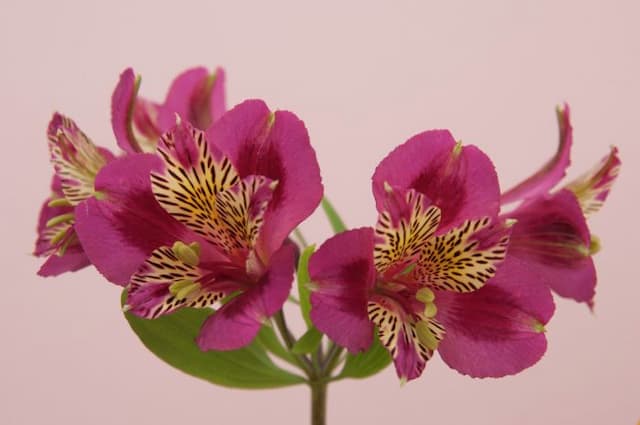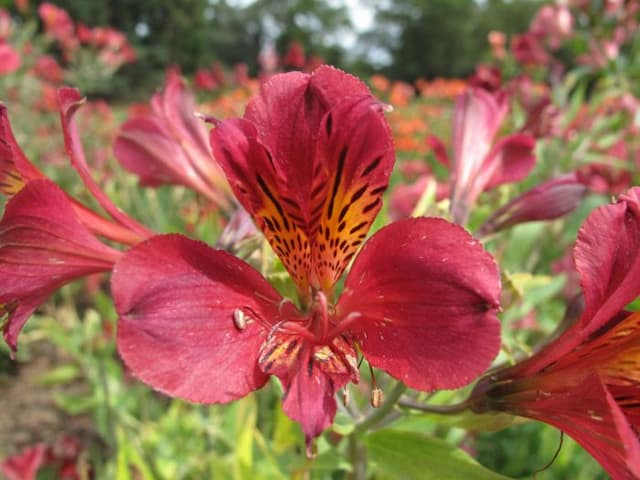Peruvian Lily Alstroemeria 'Apollo'

ABOUT
Alstroemeria 'Apollo', commonly known as the Peruvian Lily or Lily of the Incas, features a striking display of blooms that capture the eye with their unique and vibrant coloring. The flowers are typically a blend of creamy white and yellow, delicately brushed with rich, strawberry pink streaks and freckles which give each petal a distinct and attractive appearance. The petals are slightly recurved, which adds a touch of elegance to the flower's overall shape, giving it a slightly trumpet-like silhouette. In the center of each blossom, the reproductive parts, including stamens and pistils, are often visible, adding an extra layer of detail with their contrasting colors. The foliage of Peruvian Lily is also quite lush and attractive, with slender, lance-shaped leaves that grow in a dense, parallel arrangement. The leaves are a deep green color, providing a lush backdrop that accentuates the vibrancy of the flowers. The plant is known for having multiple stems that emerge from a base of tuberous roots. Clusters of these beautiful blooms are typically found at the tips of the strong stems, giving the impression of an informal bouquet. Due to the combination of the flower's colors, the Peruvian Lily 'Apollo' is often used for ornamental purposes in gardens and flower arrangements. It offers a freshness and exotic flair wherever it is planted or featured.
About this plant
 Names
NamesFamily
Alstroemeriaceae
Synonyms
Peruvian Lily, Lily of the Incas, Parrot Lily
Common names
Alstroemeria 'Apollo'
 Toxicity
ToxicityTo humans
The Peruvian Lily, while stunning in bouquets, harbors a sneaky irritant. One might not think twice before touching or casually nibbling a petal, but the sap lurking within can cause mischief. If that sap graces your skin, a rash local to the encounter's site might pompously make a debut. But if curiosity leads to ingesting parts of the Peruvian Lily, you might find yourself in a tummy tumult, with nausea, vomiting, or diarrhea as unwanted guests. It's a reminder to admire with eyes, not with taste.
To pets
Peruvian Lilies extend their toxic tendencies to pets as well. Should your curious cat or dog decide to sample this floral delicacy, they might soon regret it. These plants can cause gastrointestinal upset, showing up as vomiting or diarrhea. Always a prudent move to keep these blossoms out of paw's reach, lest your four-legged companion's exploratory nibble ends up in a trip to the vet.
 Characteristics
CharacteristicsLife cycle
Perennials
Foliage type
Deciduous
Color of leaves
Green
Flower color
Mixed
Height
2-3 feet (60-90 cm)
Spread
1-2 feet (30-60 cm)
Plant type
Herb
Hardiness zones
7
Native area
South America
Benefits
 General Benefits
General Benefits- Long Blooming Season: Alstroemeria Apollo produces flowers for extended periods, often from late spring through early fall.
- Vibrant Colors: It features captivating and vividly colored blooms which can range from yellows, pinks, oranges, to purples and reds, adding a splash of color to any garden or bouquet.
- Attracts Pollinators: The flowers attract pollinators such as bees and butterflies, contributing to the health of your garden's ecosystem.
- Cut Flower Usage: Alstroemeria Apollo is popular as a cut flower due to its long vase life, making it great for floral arrangements and bouquets.
- Drought Tolerance: Once established, Alstroemeria Apollo shows a good degree of tolerance to periods of drought, reducing the need for frequent watering.
- Low Maintenance: It requires minimal care once established, making it a convenient choice for gardeners of all levels of experience.
 Medical Properties
Medical PropertiesThis plant is not used for medical purposes.
 Air-purifying Qualities
Air-purifying QualitiesThis plant is not specifically known for air purifying qualities.
 Other Uses
Other Uses- The Peruvian Lily, when dried and pressed, can be used in decorative crafts such as creating bookmarks, greeting cards, or framed botanical art.
- Petals of the Peruvian Lily can be used in natural dye-making processes to add color to fabrics, yarns, or paper, often resulting in unique and delicate shades.
- The flower's unique shape can inspire patterns in design fields, such as fashion and textile design, where its form and colors can be stylized or abstracted.
- Thick, sturdy stems of the Peruvian Lily can be repurposed in miniature construction projects for model landscapes or as natural stakes for supporting other small potted plants.
- In culinary arts, while not common and typically not recommended for consumption, the petals may be used as an exotic edible garnish for specialty dishes, but one must ensure they've not been chemically treated and are safe to consume.
- Floral photography enthusiasts often use the Peruvian Lily as a subject for its rich colors and intriguing shapes, enhancing their portfolios with its captivating beauty.
- Some practitioners of ecotherapy might incorporate the Peruvian Lily into therapeutic gardens or arrangements to help stimulate mental and emotional well-being through their vibrant presence.
- The stem and foliage of the Peruvian Lily can be used to create plant-based sculptures or to add structural interest in avant-garde floral design competitions.
- Peruvian Lilies can serve as a teaching tool in botany and horticulture classes, demonstrating principles of plant reproduction, hybridization, and care in a practical setting.
- The seeds of the Peruvian Lily can be used in educational activities with children, teaching them about the life cycle of plants and the basics of seed germination and growth.
Interesting Facts
 Feng Shui
Feng ShuiThe Peruvian Lily is not used in Feng Shui practice.
 Zodiac Sign Compitability
Zodiac Sign CompitabilityThe Peruvian Lily is not used in astrology practice.
 Plant Symbolism
Plant Symbolism- Devotion and Friendship: Alstroemeria, also known as Peruvian Lily, often symbolizes a strong bond of friendship and mutual support between two people, making it a popular gift among friends.
- Wealth, Prosperity, and Fortune: The Peruvian Lily is sometimes associated with wealth and prosperity, possibly because of its long-lasting nature and the lush, full appearance of its blooms.
- Achievement and Aspiration: The intricate patterns on the petals of the Peruvian Lily can represent striving toward goals and the achievement of aspirations.
- Mutual Support: This plant often stands for the mutual aid and support shared in a relationship, symbolizing the interdependence of individuals.
 Water
WaterPeruvian lilies, such as the Alstroemeria 'Apollo', require consistent moisture and should be watered once the top inch of soil feels dry to the touch. This might typically be once or twice a week depending on weather conditions. During the growing season, a weekly watering that provides about a gallon of water per plant will encourage healthy growth. However, it's important to reduce watering in the winter when the plant is dormant, possibly to just once every few weeks to prevent the roots from rotting.
 Light
LightPeruvian lilies like Alstroemeria 'Apollo' thrive best in bright, indirect sunlight. A spot that receives morning sunlight with some afternoon shade is ideal. Avoiding the harsh afternoon sun can help prevent the leaves from scorching.
 Temperature
TemperaturePeruvian lilies prefer temperatures between 65°F and 80°F. The Alstroemeria 'Apollo' can survive minimum temperatures down to around 23°F but should be protected from frost. For best growth, maintain temperatures within the preferred range and avoid exposure to extremes, including sudden temperature fluctuations.
 Pruning
PruningPeruvian lilies benefit from pruning to remove faded flowers and stimulate reblooming. Cut back the spent stalks of the Alstroemeria 'Apollo' to the ground level. Pruning is recommended throughout the blooming season whenever blooms fade. At the end of the season, or in early spring, prune any dead or damaged foliage to keep the plant healthy and well-groomed.
 Cleaning
CleaningAs needed
 Soil
SoilPeruvian lily (Alstroemeria 'Apollo') thrives in a well-draining soil mix rich in organic matter. A mixture of two parts peat or coco coir, one part perlite or sand, and one part compost or aged manure is ideal. The preferred soil pH for Peruvian lilies is slightly acidic to neutral, ranging from 6.0 to 7.0.
 Repotting
RepottingPeruvian lilies like Alstroemeria 'Apollo' should be repotted every two to three years to replenish the soil and provide room for growth. Replant in a slightly larger pot with fresh soil mix to encourage vibrant blooms.
 Humidity & Misting
Humidity & MistingPeruvian lilies prefer moderate humidity levels. The best humidity range for Alstroemeria 'Apollo' is between 40% to 60%. Avoid overly dry air to maintain healthy foliage and flowers.
 Suitable locations
Suitable locationsIndoor
Bright light, avoid direct sun, moderate water, and humidity.
Outdoor
Full sun to partial shade, sheltered from wind, fertile soil.
Hardiness zone
7-10 USDA
 Life cycle
Life cycleThe life of an Alstroemeria 'Apollo', commonly known as Peruvian Lily or Lily of the Incas, begins with seed germination, which requires a warm and moist environment to sprout. The seedling stage follows, during which the young plant develops its first true leaves and a root system. As it enters the vegetative stage, the plant grows vigorously, producing multiple stems, leaves, and a strong root system. The Peruvian Lily next enters the flowering stage, where vibrant blooms appear, typically during late spring through summer, attracting pollinators. After pollination, the plant produces seed pods if conditions are favorable, completing the reproductive cycle. Eventually, the plant enters a period of dormancy, particularly in cooler climates, where it conserves energy before restarting the cycle the following growing season.
 Propogation
PropogationPropogation time
Spring-Early Summer
Propogation: Alstroemeria 'Apollo', commonly known as the Peruvian Lily or Lily of the Incas, is best propagated by division, which is the most popular method and should be performed in the late winter or early spring just before new growth begins. To propagate by division, carefully dig up the clump of tubers and rhizomes from the ground, making sure to keep a good amount of soil around the roots. Gently separate the clump into smaller sections, each with at least one growth point or eye. These divisions can then be immediately replanted in a well-draining soil mix at the same depth they were growing previously. Water the newly planted divisions thoroughly to help establish them. It is important to handle the fleshy roots carefully as they can be easily damaged. This method allows the grower to expand their collection or rejuvenate older clumps that have become too dense.






![Peruvian lily [Inca Coral]](/_next/image?url=https%3A%2F%2Fplants-admin.emdemapps.com%2Fimages%2Fplants%2F%2Fimages%2F604b5b79b85ce.png&w=640&q=75)
![Peruvian lily [Inca Exotica]](/_next/image?url=https%3A%2F%2Fplants-admin.emdemapps.com%2Fimages%2Fplants%2F%2Fimages%2F604b5ec0e34a9.png&w=640&q=75)
![Peruvian lily [Inca Milk]](/_next/image?url=https%3A%2F%2Fplants-admin.emdemapps.com%2Fimages%2Fplants%2F%2Fimages%2F604b5f14b0b6a.png&w=640&q=75)
![Peruvian lily [Inticancha White Pink Blush]](/_next/image?url=https%3A%2F%2Fplants-admin.emdemapps.com%2Fimages%2Fplants%2F%2Fimages%2F604b538014919.png&w=640&q=75)